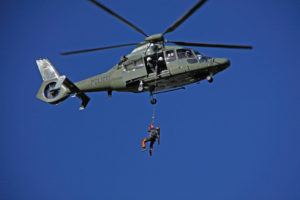
By Michael Solomon, 10x Management Co-Founder
As the world now knows, on August 25th Hurricane Harvey made landfall at Rockport, Texas, bringing 130-mph winds and more than 50-inches of rainfall to towns and cities along the Gulf Coast. Millions of people were forced to evacuate their homes, 71 lives were lost, and billions of dollars in damage was caused to businesses and residential properties throughout the area.
But as the storm swept north through Texas, volunteers from around the world were gathering on Reddit and social media to do what they could to help. Users on Twitter and Facebook worked around the clock to share emergency contact details, draw attention to the people asking for help online, and to raise the alarm for those still trapped in the hurricane’s path.
Tracking the news from his home, 10xer Greg Sadetsky realized that his technical skills and experience with mapping software put him in a unique position to be able to help. Connecting with other volunteers over Slack, Greg set to work designing a mapping tool that could help rescuers to safely navigate the affected areas.
“The first map that I put together didn’t really get picked up,” Greg said. “There were some talented people working on tools to help rescuers and I think mine got a little lost in the noise. A few hours later though, I got an email from Nathan, a helicopter pilot, instructor and Lieutenant with the US Coast Guard, asking if I could work directly with them on a tool for dispatching helicopter crews across the hurricane-hit area. Needless to say, I was glad to be called on to help.”
For the next four days, Greg carried his laptop with him 24/7, responding to urgent requests from Nathan and other Coast Guard personnel. In constant communication with crews on the ground in Texas, Greg produced mapping software that could be customized by the Coast Guard to display the exact information their pilots needed.
“I think the map had around 40 features by the time it was finished, and it was being refreshed with new information every 60 seconds. We’d worked together on layers that could be added to the map which showed the locations of hospitals, safe landing zones, no-fly zones – everything the pilots needed to conduct safe rescue missions.
“Towards the end of my time working with the Coast Guard, we had implemented a real-time list of airborne helicopters and their current tasks too – something that I think really benefitted them. This let the dispatchers on the ground assign particular helicopters to rescue missions and to see at a glance the status and destination of any airborne helicopter crew.”
Between August 28th and September 1st, during the worst of the hurricane, Greg’s mapping tool was used by pilots to conduct more than 700 missions, assisting in the rescue of more than 1,700 stranded people, transportation of vital medical resources, and urgent medical evacuations throughout the Houston area.
Writing as the cleanup efforts began in the wake of the storm, Commander James Spitler of the US Coast Guard Air Station in Houston praised Greg’s contribution to the rescue efforts (the complete letter is below):
“Initially our Air Operations Group was struggling with organizing the volume of data that was pouring into our incident command post. One of my officers noticed the volunteer work [Greg was] doing to synthesize social media calls for assistance, reached out to [him], and ended up finding the perfect person to help us with this disaster response.”
“[Greg’s] custom mapping software gave our operational managers the ability to organize and view hundreds of calls for assistance, map dozens of designated evacuation areas, and monitor the rapidly changing conditions at area hospitals. Within hours, [Greg’s] work gave my pilots a product that was an absolute ‘game changer’.”
As the hurricane dissipated and the situation on the ground became less urgent, Greg’s work was taken over by in-house teams and he was given a chance to reflect on the past four days.
“More than anything I’m just proud to have been part of a project that did some good in the middle of all that chaos,” Greg said. “I realised early on that I could help the search and rescue crews on the ground and I felt almost duty-bound to use what I knew to try and help.
“I feel very lucky and grateful that I was able to play even a small part in helping with the rescue efforts. It was great work to be involved in – a real collaborative effort with the men and women of the US Coast Guard to try and provide their pilots with the vital information they needed. These first responders are the real heroes and being able to give them better resources to rescue more people more quickly is very fulfilling.”
As the scale of destruction became clear in the days and weeks following Hurricane Harvey, Greg had already started to think about how the technologies he works with could be used to help in similar situations in the future.
“There’s nothing certain in place yet, but I can see potential in what was developed over those few days during Hurricane Harvey. I’m excited to see whether my work could have applications in helping rescue efforts in other disaster areas in the future, and it’s certainly something that I’m going to be taking a look at.”
Read the letter from Commanding Officer James Spitler of the US Coast Guard to Greg Sadetsky HERE.
About Greg Sadetsky:
Greg Sadetsky is a senior Python and JavaScript developer with substantial experience in full stack development, rapid prototyping, and project management. After cofounding a mapping startup whose customers included Google, Microsoft, MSNBC, and NORAD (the startup was sold to Apple), he left to complete a Master of Science degree at a neuroscience institute, where he applied computer vision to multiple sclerosis research. He has since taught Python and Django at Salesforce and Cisco, and worked as a freelance software developer at Verizon, Hautelook, and McGraw-Hill, to name a few. In 2016, he and his team member Ann-Julie Rhéaume were awarded second place in the NIH National Library of Medicine’s Pill Image Recognition Challenge. Greg contributes to an Open Source echography project and develops Google Chrome extensions in his spare time. Based in Montreal, his interests include data wrangling and robotics. Greg is proud to have done many many nonprofit projects for countless organizations including: Birthright, Idealist, Musicians On Call, and echOpen to name a few.
To Interview Greg or other press inquires, please contact Michael Solomon at 10x Management via email or phone (212) 501-0748.

